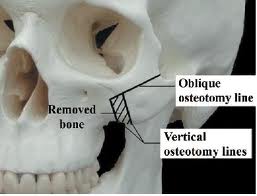The shape of the face obviously changes in different geographic regions and cultures. This is certainly true in facial aesthetics between Western and Asian cultures. One of the facial features that is really different between these two cultures is the cheek region. In the Western face a high or protruding cheek is regarded as both youthful and aesthetically pleasing. In contrast, high or prominent cheekbones is regarded as unaesthetic in the Asian face. In a face that is generally smaller overall, prominent cheekbones can look really big in an Asian face.
Because of the desire to not have protruding cheeks in an Asian face, cheek reduction or reduction malarplasty is a very common operation in Eastern Asian countries. It is an extremely uncommon facial operation in Caucasians although I have seen and done a few such cheek reductions over the years in my Indianapolis plastic surgery practice.
Most cheek reductions use both an anterior and posterior osteotomy. The anterior osteotomy goes somewhere through the body of the cheek or zygoma while the posterior osteotomy cuts the attachment of the zygomatic arch to the temporal bone. The posterior osteotomy has very little variation in performing it. But the anterior osteotomy cut has some variation in placement and design due to the different sizes and shapes of the zygomatic bone. How it is cut and how much bone is removed determines how much volume reduction is achieved and whether the area of maximum cheek protrusion is effectively reduced.
The easiest anterior approach to cheek reduction is to separate the front edge of the zygomatic arch where it attaches to the posterior body of the zygoma. This junction is certainly easy to see intraoperatively from the intraoral approach. While easily cut, however, shifting of the zygomatic arch medially can leave the protrusion point of the cheek bone in some patients unchanged. This can be remedied by burring the body of the zygoma down to be even with the repositioned zygomatic arch. However, it can be hard to get the junction between the bone edges smooth and it may also be structurally unstable.

In an interesting paper published in the November 2011 issue of Plastic and Reconstructive Surgery, plastic surgeons from Tokyo studied the position of the ‘summit’ of the zygoma. The summit is just another name for the maximal point of cheek protrusion. Knowing where it is located in any patient is obviously important when planning the cheek reduction operation. Their study showed that the summit of the zygoma is located medial to the junction of the frontal process and the zygomatic arch. The bone incision line in cheek reductions, therefore, should be placed medial to the posterior edge of the frontal process to get effective reduction of the protrusion. Not surprisingly, the zygomatic summit is higher in men than women due to a bigger cheekbone and then so should the bone incision be placed also.
Prior to cheek bone reduction surgery, I like to get a simple submental facial x-ray to locate the the point of maximal bony cheek protrusion which can be easily seen on the film. This helps to determine the best cheek osteotomy type.
Dr. Barry Eppley
Indianapolis, Indiana


